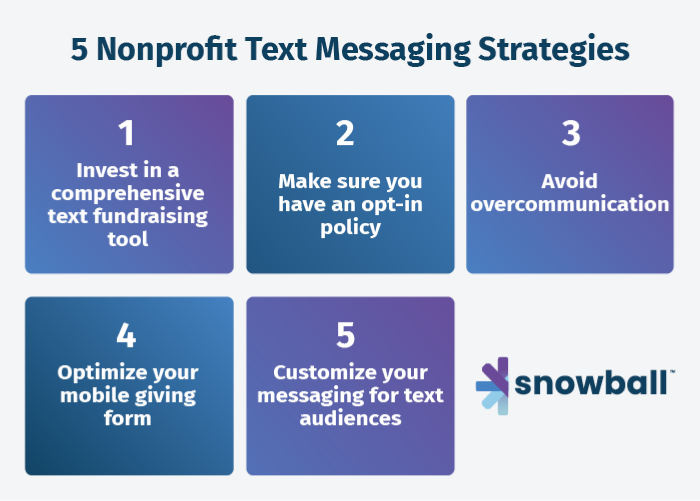As of 2021, 3.8 billion people own smartphones. What’s more, statistics from TechJury show that SMS has a 98% open rate compared to email marketing and 60% of customers read texts within 5 minutes of receiving them.
Clearly, your supporters are highly reachable via text message, so why not take the leap? Text messaging can be a versatile asset for your nonprofit’s outreach strategies, enabling you to send outbound text marketing messages, run text fundraising campaigns, and more effectively engage your supporters. To help you get a better understanding of how text messaging can help your nonprofit, we’ll cover these topics in more detail:
- What Is Nonprofit Text Messaging?
- How Nonprofits Use Text Messaging
- 5 Nonprofit Text Messaging Strategies
These strategies will help you make the most of text messaging to acquire new supporters, engage existing ones, improve communications, and position yourself as a forward-thinking organization. Are you ready to explore how nonprofit text messaging can work for your organization? Let’s get started!

What Is Nonprofit Text Messaging?
Nonprofit text messaging can take a few different forms. Primarily, it allows you to reach your supporters through outbound messages as well as enabling them to give on the go by submitting a gift right from their mobile devices.
To send out mass communications to donors who have opted in, your organization will need a tool that includes outbound text messaging features. This can be a great method for quickly and directly reaching your supporters. However, outbound text messaging alone may not be enough for your organization.
If you’re running a fundraising campaign and want to utilize text messaging to secure donations, text-to-give capabilities will be essential in addition to outbound text messaging. Before you get started you’ll have to understand how to get set up, the different ways that nonprofits use text messaging, and some best practices.
How can nonprofits send and receive text messages?
The first step to get started will be to invest in a text fundraising tool. In order to send messages to your supporters, make sure that the software you pick has outbound text messaging. These outbound text messaging solutions can vary, with some text messaging services coming as a part of a larger, more comprehensive suite of fundraising tools. Typically, it’s most effective to invest in a tool that enables both outbound text messaging and inbound text messaging for text-to-give campaigns.
For text-to-give, once you have selected your software provider, you’ll set a phone number where donors will send texts. Then all your donors have to do is text in to begin the gift-giving process. A link to your mobile donation page will automatically be sent to their devices, allowing them to give within seconds.
Benefits of Nonprofit Text Messaging
Text messaging is increasingly useful as smartphone usage rates increase. The percentage of adults who own smartphones in the U.S. went up from 68% in June of 2015 to 85% in February of 2021, according to data from Statista. That’s a whole lot of people you have the potential to reach through text messaging! In addition to widening your pool of potential supporters, there are also several other benefits to text messaging for nonprofits:- Stand out from the crowd. Despite the high usage of smartphones in the U.S. (and many other countries), there are many nonprofits still not using text messaging to reach their supporters. Being one of the first in your niche to take this step can set you apart as a forward-thinking organization.
- Build donor relationships. Text messaging can be a much more personal way of communicating with donors. Besides catching them in moments where they are away from their other devices, it also allows them to more easily respond or be directed to an actual team member directly on their phone.
- Market on a budget. Compared with some larger, more traditional outreach methods, text messaging can be much more affordable. A nonprofit text messaging campaign can not only be cheaper but can also be much simpler to pull off.
- Reach donors quickly. While other methods like email, social media, and even direct mail can still be useful, none of them are as direct and quick as a text message. Text messaging not only reaches supporters quickly, but it also tends to be more personal and an easier way for them to digest information because of the short nature of text messages.

How Nonprofits Use Text Messaging
Just like any other form of communication, there are many different appeals that you can send out to supporters via text. Depending on your needs and what other communication channels you have set up, you may use text messaging for all of these things or just a select few. Nonprofits often use text messaging to:
- Send outbound messages to generate support
- Steward new donors
- Organize volunteers
- Raise brand awareness by tying keywords to campaigns
- Boost awareness for time-sensitive events
- Increase engagement during events, both in-person and virtual
- Reach donors on the go
Text messaging is a multi-faceted tool that you can use for a variety of different purposes. And because of the immediacy of this method, it can be great for getting the word out about a variety of initiatives.

5 Nonprofit Text Messaging Strategies
1. Invest in a comprehensive text fundraising tool
To get started with text messaging, you’ll need to select a tool that has all of the capabilities and features that you need. Ideally, you want a comprehensive tool that enables you to run a text-to-give campaign while also allowing you to send outbound text messages to supporters.
The features you need will vary depending on your intended use of text messaging, however, there are a couple of features that will be essential for any nonprofit organization looking to run a text-to-give campaign:
- Host unlimited text-to-give campaigns. The last thing you want is to invest money into a text-to-give tool only to find out that you’re limited in how much you can utilize it. Avoid this by looking for a tool with unlimited campaigns.
- Seamlessly integrate with the rest of your fundraising system. Because you already have all of your donor data and all of your fundraising efforts incorporated into your existing software, it’s much more time and cost-effective to find a nonprofit text messaging tool that can integrate directly into your existing system.
- Track your donations. It’s important to be able to see your fundraising campaigns progress at all times and, better yet, share that progress with your supporters. Donation tracking and fundraising thermometer tools will allow you to gauge your journey towards the financial finish line and engage donors with updates on your collective success.
Finding the right tool doesn’t have to be a hassle if you know what you’re looking for. Look for tools that include the features you need to reach your supporters and run effective text fundraising campaigns.
2. Make sure you have an opt-in policy
Before you start sending outbound text messages, you need to ensure you have the recipient’s consent. Sending uninvited texts to donors who don’t want this type of engagement is not only illegal but also risks your relationship with supporters and your nonprofit’s reputation.
While nonprofits don’t require written consent, you still need to have donors provide their phone numbers with the knowledge that they’ll be receiving communications from you. You can do this through a form on your website or a physical form if you are in person.
The Telephone Consumer Protection Act actually specifically forbids businesses from texting consumers without their consent so this step is extremely important. The last thing you want is legal trouble when it could have easily been avoided.
3. Avoid over-communication
As with any platform, it’s possible to overdo it. Just because your messages are short and easy to send does not mean you should be sending more than are actually necessary. Bombarding your supporters’ phones runs the risk of alienating them, leading them to opt-out or simply ignore your messages. As you would with direct mail, email, or social media posts, do your research and use your best judgment to find a balance of engaging supporters regularly without overwhelming them.
Here are a few tips to ensure effective communication:
- Be concise. Text messages are meant to be short and quick to read. If you have a message that requires a longer format, it may be better suited to an email or even an actual letter.
- Use simple language. Similarly, text messages are not the place for showing off your impressive vocabulary. Your supporters will appreciate simple and to-the-point communications when it comes to text messages. Focus on clarity and brevity.
- Send prompts, not unsolicited information. If you have an important message, it may be tempting to send all of it immediately. However, because your supporters will likely stop reading an excessively long message, it’s more effective to prompt them to “Get more information” or respond to learn more before sending them all of the information.
Texting your supporters may be a new experiment for you, but just like any other platform, it has its own set of best practices and rules. Use our tips, the experience of your own staff, and supporter feedback to continually improve your text communication style for maximum effectiveness in the minimum amount of characters.
4. Optimize your mobile giving form
Often, the goal of texting your supporters is to direct them to your mobile giving page. With this in mind, you need to make sure your mobile giving form is fully optimized to be easily accessible from a phone screen. If your supporters have trouble filling out your form, your messages directing them to donate are ineffective and not a good use of your time.
To ensure a user-friendly mobile donation form, we recommend that you:
- Simplify the form. Although it may be tempting to get as much information as possible from your donors, minimizing the number of required fields will make the form much easier to fill out. This increases the chance that supporters will actually complete the entire form.
- Embed the form right into your donation page. The more your donors have to click and navigate, the more likely they are to get distracted or frustrated. Minimize unnecessary redirects with a giving form that can be integrated directly into the donation page.
- Use large text to make your form legible to mobile users. You don’t want your supporters to have to pinch, zoom, and scroll to fill out your form. Using large text will help reduce frustration while navigating a donation page on a phone screen.
- Keep the design simple. Because supporters will be using their phones, a complicated design may be too difficult to navigate with just one or two fingers. Save your impressive graphic design for your desktop website!
- Use portrait orientation. This ensures that it fits easily on a phone screen and doesn’t require rotating and adjusting from the user.
When it comes to mobile giving, your top priority should be making it user-friendly and easy to navigate. Of course, you’ll want to include your branding and make it look nice, but your primary focus should be usability. User experience strategies like A/B testing can help you to make elements like your branding, and text size as user-friendly as possible. Create a few different versions of your donation form and have users give their feedback on their experience to help you find the best design for your supporters.
5. Customize your messaging for text audiences
Just like with any other new communication platform, your text messaging strategy and tone should be adjusted to best suit that platform and the audience you’re reaching. The pool of supporters you’re reaching through text messages is likely different from your audience on Instagram or for direct mail, and you will need to adjust your messaging approach to keep them engaged. For example, data such as age, income range, profession, giving potential, and similar personal and financial demographics can help you to personalize your messaging.
While you won’t necessarily have all of this information when you first start your text campaigns, it may be helpful to collect demographic information about your text messaging audience to help you further optimize your strategy in the future. To get you started, here are a few initial communication tips:
- Keep messages short. When a supporter gets a massive block of text that’s not from a close friend or family, they are much more likely to simply not read it fully. Regularly getting excessively long messages may even prompt them to unsubscribe from your text messages. Be concise and direct with your messages.
- Use a more casual tone. Text messages are not formal donation request letters — relax your tone a bit to better suit the medium and the audience you’re reaching. Snowball’s outbound text messaging tool even lets you use emojis to inject a little fun into your messaging. The brand voice you have already established and your knowledge of the target audience you’re reaching will determine how casual your message can be.
- Don’t text too frequently. Overwhelming your supporters with too many text messages can cause them to unsubscribe, similar to overly lengthy text messages. Focus on the most essential messages and direct them to pages for more information if it’s necessary.
From your email marketing to social media strategies, you already know the importance of crafting unique messaging for different audiences and platforms — text messaging is no different! Use the same best practices, research, and testing to figure out the most effective messaging for your specific audience.
When paired with a strong outreach strategy and the right software tools, nonprofit text messaging can be a powerful marketing and communication tool for nonprofit organizations. To make the most of this medium, your team can get started by following our strategies while adapting them to fit your supporters. After all, you know your donors best. Good luck!
Whether you want to learn more about text messaging or utilize it to support your other fundraising methods, these additional resources can help you get started:
Additional Resources
- Text-to-Give | Complete Guide for Nonprofits and Fundraisers: If you’re ready to start using text-to-give, this in-depth guide will help you understand the ins and outs of text-to-give campaigns.
- Online Fundraising In 2021 | Complete Guide and Resources: In addition to text-to-give, this resource has more online fundraising ideas to help you reach your fundraising goals.
- Fundraising Events | 100+ Ideas to Raise More in 2021: Text messaging can be used to help you market your fundraising events, regardless of which of these 100+ different event ideas you choose to pursue!







